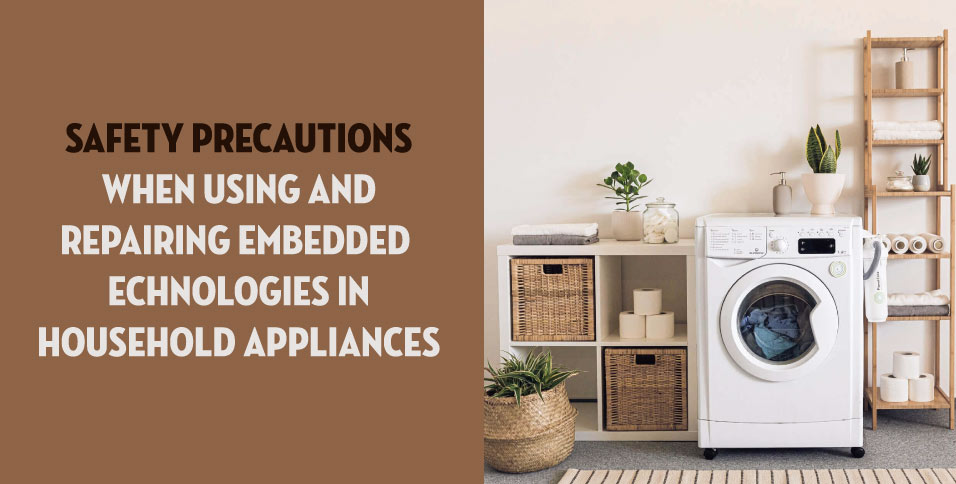In the modern world, embedded technologies in household appliances have become an integral part of everyday life. They provide convenience, efficiency, and innovative capabilities, but the use and maintenance of such equipment requires special attention to safety issues.
This article is devoted to the study of safety during the operation and repair of embedded technologies in household appliances. Its purpose is to make you aware of the risks that can arise when using these technologies and to provide practical advice on how to use them safely.
Whether you are a consumer who uses appliances on a daily basis or a professional who performs repairs and maintenance, safety knowledge is an integral part of your experience. Appropriate training and conscious adherence to safety rules will not only ensure your personal safety, but also increase the efficiency and lifespan of your appliances.
Potential dangers of using embedded technology
The use of household appliances, especially those with built-in technology, is inextricably linked to electrical risks. Failure to comply with safety rules when working with electrical appliances can lead to serious consequences, including electric shock or even fire. Power grid instability, deficiencies in wiring, and malfunctioning equipment can lead to short circuits and overheating, creating a potentially dangerous situation.
Many embedded technologies in household appliances can have customizable parameters such as temperature, pressure, speed, etc. Improper use or attempts to change these parameters can lead to unexpected consequences. For example, incorrectly setting the temperature in a refrigerator can cause food to defrost or, conversely, freeze, which increases the risk of food poisoning or food destruction.
The use of appliances with built-in technology can also lead to potential emergencies. For example, an accidental switching on of the device, overheating, or malfunctioning of sensors can cause serious consequences, such as fires, emissions of harmful substances, or damage to the equipment.
To avoid these risks, it is important to follow all safety rules and contact qualified professionals if necessary.
General safety rules for using embedded technologies
Properly turning on and using embedded technologies in household appliances are essential steps to ensure safety. Before turning on the device, you should carefully read the manufacturer’s instructions and make sure that all elements of the equipment are properly connected and installed. It is also important to follow the operating instructions to avoid unforeseen situations and damage to the device.
Avoiding overheating and overloading is a key aspect of safe use of embedded technology. Before using the equipment, it is important to check that it is designed to perform the desired function and that the loads do not exceed the recommended values. Also, avoid blocking the ventilation openings of the device and place the equipment on a stable surface to ensure free air circulation.
It is important to always disconnect the appliance from the mains when carrying out repairs or maintenance. This prevents accidental electric shock and possible damage to the equipment. Before performing any repair work, make sure that the equipment is completely turned off and disconnected from the power source.
Observance of these general safety rules will significantly reduce the risk of dangerous situations when using and servicing embedded technologies in household appliances.
Safety precautions for repairing embedded technologies
Repair work on embedded technology in household appliances requires a high level of skill and training. Repairs should be carried out only by qualified specialists who have not only technical knowledge but also understand the safety principles and risks associated with working with electrical devices and other complex systems.
A number of safety precautions must be taken when repairing embedded technologies. This includes using insulating materials to protect against electric shock, using the right tools and equipment, and avoiding contact with hot or sharp edges of devices. It is also important to carefully check and disconnect the electrical power before starting work.
When repairing embedded technology, you must use proper protective equipment. This may include safety glasses, gloves, masks, and other equipment that reduce the risk of injury and poisoning. In addition, it may be necessary to use special electrical protection equipment such as insulating gloves or galoshes.
Conclusion
In this article, we have reviewed important safety aspects of using and repairing embedded technologies in home appliances. It is extremely important to be aware of the potential risks that can arise when using these technologies and to take appropriate precautions to prevent them.
The use of safety precautions, proper switching on and use of devices, prevention of overheating and overloading, and the use of necessary protective equipment during repairs are key safety aspects. In addition, it is important to train and educate personnel on safety issues, as well as to keep their knowledge up to date.
Only if these principles and recommendations are followed can the safety of users be ensured during the operation and maintenance of embedded technologies in household appliances. Reliable safety is an important prerequisite for the successful and safe use of modern technology in the home.
Also read: Restoring Appliance Functionality and Efficiency in Regina
















